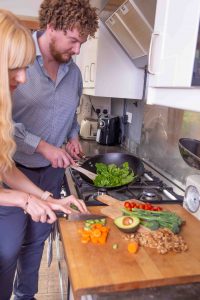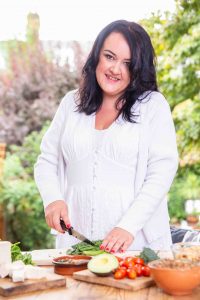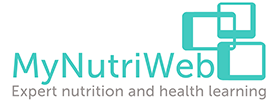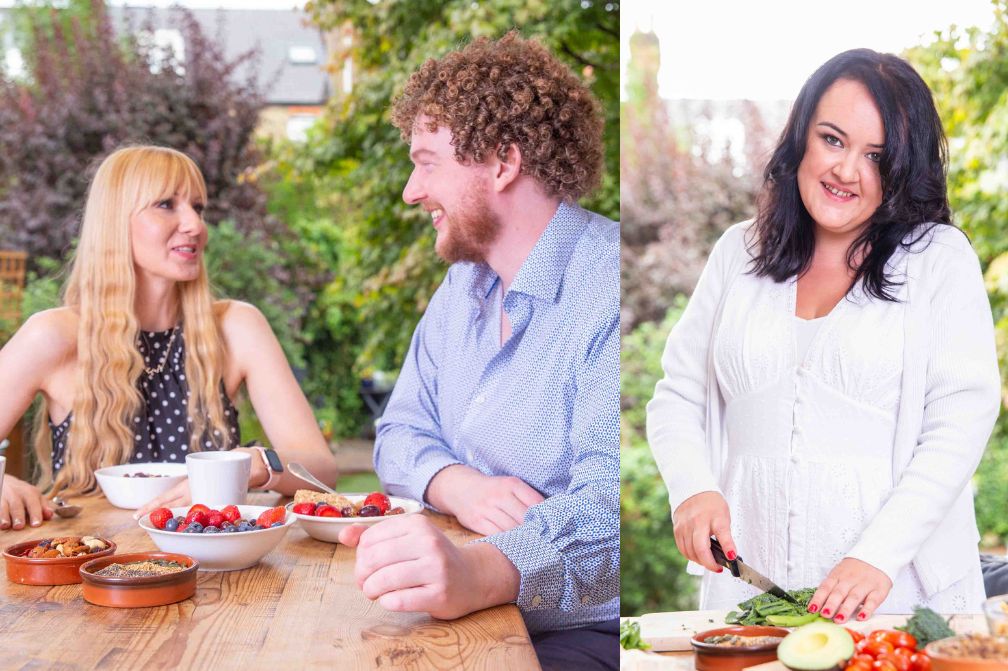What it’s really like to follow a cholesterol lowering diet.
By Juliette Kellow, Registered Dietitian
Three young adults share their lived experience of the Ultimate Cholesterol Lowering Plan©.
October is HEART UK’s National Cholesterol Month, an annual campaign designed to make everyone – men and women, young and old – more aware of high blood cholesterol and how it can be managed.
Often perceived as a condition we only need to worry about in later life, the latest UK statistics confirm a massive 29% of adults aged between 25 and 34 have total cholesterol above the healthy level of 5mmol/L, rising to 45% of 35 to 44 year olds and 57% of 45 to 54 year olds. It’s a stark reminder that raised cholesterol doesn’t just affect us in our senior years. Nor is it primarily a problem for men! From mid-life onwards, the greatest number of cases are in women.
With so many younger people at risk, HEART UK recommends all adults have their cholesterol checked so they can take action if necessary. Cholesterol tests are included in health checks offered routinely to adults aged 40 and above in England, Scotland and Wales, but the latest statistics indicate testing in our 30s is warranted.
It’s vital advice as high cholesterol is a significant risk factor for cardiovascular disease, a term used for all diseases of the heart and circulation, including coronary heart disease, heart failure and stroke – and a health problem that 7.6 million people in the UK currently live with.
As well as quitting smoking and being more active, making dietary changes is a key lifestyle intervention for lowering cholesterol. One popular approach is the Ultimate Cholesterol Lowering Plan© (UCLP©), an evidence-based diet developed by HEART UK. The plan is modelled on the principles of the Portfolio Diet – a plant-based diet that includes a ‘portfolio’ of four cholesterol-lowering foods. The Portfolio Diet has been shown to be highly effective, lowering total cholesterol by 12%, LDL cholesterol by 17% and the overall risk of coronary heart disease over 10 years by 13%. But it’s a strict – almost vegan – plan making it difficult for many people to follow in the long term. The UCLP© includes the same components of the Portfolio Diet but is adapted to be more practical, achievable and flexible so a wider range of people benefit.
The UCLP© consists of three steps:
Step 1 – Boosting motivation to help people make changes to their diet – and then maintain them.
Step 2 – A heart-healthy foundation diet that focusses on lowering saturated fat, partially replacing saturates with unsaturated fats, opting for more plant proteins, and increasing fruit, veg, fibre and sustainably sourced oil-rich fish.
Step 3 – The addition of four plant foods: soya, nuts, oats and barley (which are rich in beta-glucans) and foods fortified with plant stanols or sterols. All these foods have been shown to significantly reduce cholesterol on their own, which means people can choose the ones they would like to add. However, studies show there’s a cumulative effect so the more that are added, the greater the cholesterol lowering benefits.
It sounds great in theory. But just how easy is it for people to follow? Here, we speak to three adults who discovered they had high cholesterol at a young age and so followed the UCLP©…
Ross, 33, and Agata, 39
Ross and Agata both work in engineering science and met when they were doing their PhD’s a few years ago. They were both shocked when they discovered they had high cholesterol while only in their 30s.
How did you feel when you were diagnosed with high cholesterol?
Ross: “At just 33, I was surprised and shocked to find my cholesterol was high. I was cycling to and from work every day and going to the gym two or three times a week so thought I was quite fit. It was a real wake-up call – I’d never thought about my heart health before and didn’t realise having high cholesterol could damage my heart.”
Agata: “Like Ross, I never expected my cholesterol to be high as I was still in my 30s! I was also a healthy weight and followed a mainly plant-based diet with little meat or dairy. I couldn’t quite believe it at first!”
Why do you think your cholesterol was high?
Ross: “Looking back, I’d lost focus on exercise and was eating unhealthily a lot of the time with the result being that I’d gained a lot of weight in the past few years. My Body Mass Index was pushing 35 this summer! Although Agata had a mainly plant-based diet, I didn’t eat much fruit and veg, and still ate meat most days. Bacon and salami were regulars – and I enjoyed cheese, pastries and chocolate. I now know these are all packed with sa turated fat, and too much of this can increase cholesterol.”
turated fat, and too much of this can increase cholesterol.”
Agata: “My usual healthy lifestyle fell a little by the wayside while I was studying for my PhD. Working from home meant my cycle to work stopped and I found it hard to fit in regular activity. Plus, pastries, sugary snacks, butter and takeaways had started to become regular additions to my mainly plant-based diet.”
What motivated you to start the plan?
Ross: “The shock of having high cholesterol in my early 30s was all the motivation I needed! I wanted to make changes that would help me lose weight as well as lower my cholesterol and was keen to get fitter.”
Agata: “I wanted to improve my fitness and get in the best health possible. Finding out I had high cholesterol gave me the push I needed to begin making changes for a healthier lifestyle.”
What changes did you initially make?
Ross: “My first change was to start the day with a breakfast that was low in saturated fat and higher in protein, so in came porridge with fruit and a soya alternative to milk. I added a lot more fruit and veg to the rest of my day, too – lunch would be a vegetable or bean soup with a sandwich, or a salad with plant protein.”
Agata: “I looked at making simple swaps to cut down on saturated fat such as switching butter for vegetable oils or unsaturated fat spreads. I already enjoyed soya alternatives to milk and yogurt, and occasionally used Quorn Mince, but I began using more plant-based proteins and meat alternatives in cooking, including some we were both less familiar with such as smoked and marinated tofu, tempeh and a wider range of plant and alternative protein foods such as Quorn Fillets and Pieces, and different beans, lentils and falafel.”
What bits of the plan did you find easy?
Ross: “Despite making some big changes, it didn’t feel like I was restricting my diet. In fact, it opened my eyes to the wide choice of plant foods available. I can honestly say I ate more fruit and veg in the last two months than I had in the last two years!”
Agata: “The biggest change was including more plant and alternative protein foods, which are naturally low in saturated fat. This was far easier to do than I thought it would be.”
Which UCLP© foods did you add?
Ross: “I swapped dairy milk for a soya alternative to milk and used this on cereal and in drinks. I also had oat cereal or porridge for breakfast.”
Agata: “I added far more soya products such as tofu and tempeh to my diet.”
Did you miss any foods or find anything difficult?
Ross: “I decided to cut out meat entirely and reduce the amount of cheese I ate, which was easier than I expected. Instead, Agata and I included a few portions of fish and some egg-based dishes each week as well as lots of different soya foods and drinks, Quorn mycoprotein and different beans, lentils and peas.”
Agata: “I didn’t really miss anything. The most challenging part was planning different meals and snacks as I never realised just how many foods there are to choose from or how adding more would increase variety in my meals and make them taste nicer. My overall diet now feels more balanced and I have less desire for sugary foods.”
Did you make any other lifestyle changes?
Ross: “I’ve increased my exercise levels and feel fitter and more energised and motivated to take on new challenges. On top of the activity I was already doing, I incorporated a bigger exercise session at the weekend focussing on weight training.”
Agata: “I made more effort to be consistently active. I did yoga every day, focussed on increasing my steps and included a cycle or longer walk at the weekend.”
Were there any surprises along the way?
Ross: “Because my fitness focus was on adding more weight training sessions, I wanted to make sure I included enough protein in my diet to help build and maintain muscle. I thought this might be difficult without eating meat, but I was surprised to discover plant and alternative protein foods such as soya alternatives to milk and yogurt, beans, nuts and Quorn were an easy and versatile way to achieve this whilst keeping saturated fat intakes down.”
Agata: “I didn’t always include protein in meals. Now I know it’s important to include protein-rich foods across the day. Following the UCLP© has also taught me how to make healthy choices when I go to the supermarket or eat out.”
Did the plan work?
Ross: “It totally worked! In just nine weeks, my total cholesterol plummeted from a high of 6.8mmol/L to a much lower 5.4mmol/L – a 20% drop that brings me much closer to the target level of below 5mmol/L. My LDL cholesterol also fell by 30% from 4.6mmol/L to 3.2mmol/L, again, almost reaching the target level of below 3mmol/L. I’ve also lost 2.7kg and 4cm from my waist. My results also mean that my NHS Heart Age is now 31 years, so a 1 year younger than my actual age!”
Agata: “Yes, absolutely! After nine weeks on the plan, my total cholesterol dropped by 25% from 6.5mmol/L to 4.5mmol/L and my LDL cholesterol reduced a massive 34% from 4.1mmol/L to 2.7mmol/L. Both are now well within the normal range. I’m so happy my cholesterol results are now normal.”
Any final thoughts on the UCLP©?
Ross: “I’m really surprised by my cholesterol results over this short time on a plan that was really no extra effort to follow. I’m going to keep on the UCLP© for my own health and for the environment.”
Agata: “I’m really glad I got my cholesterol checked in my 30s and have been able to adjust my eating pattern to manage it. I’d recommend any of my friends or family get theirs checked too, even if they think they eat quite well and exercise regularly.”
Beya, 41
Married for 19 years and with three children aged nine, 13 and 17, Beya’s spent the last few years balancing family life with studying at university. After graduating in the summer and embarking on a new career, as a civil servant for the Scottish Government, she was surprised to learn she had high cholesterol.
How did you feel when you were diagnosed with high cholesterol?
“It was a total shock! I was also worried when I completed the NHS Heart Age and it came out at 48 – seven years older than my actual age when I started the programme.”
Why do you think your cholesterol was high?
“Juggling family life and studying meant my lifestyle had changed in the past few years – and not for the better. Working from home meant I struggled to keep active and lacked motivation to move. I was also skipping breakfast and lunch, and regularly eating foods high in saturated fat such as processed meats, pastries, fried foods and sugary snacks. I’d put on weight and was the heaviest I’d ever been with a Body Mass Index of 28.”
What motivated you to start the plan?
“Graduating from university in the summer was a really proud moment for me but I didn’t like the way I looked in the photos. Together with the weight gain, high cholesterol result and older-than-my-years heart age, I knew I had to make some positive changes to my diet and lifestyle. I liked the idea of the ULCP© as I already enjoyed eating fruit, veg, beans, lentils and occasionally fish. Plus, my family were very supportive and happy to try new foods and meals so we could still all eat together. That was really important as I didn’t want to make separate meals for myself and wanted to provide dinners all the family would enjoy.”
What changes did you initially make?
“I started by tackling the meal skipping, then began including more plant and alternative protein foods in meals. I started reading food labels, especially looking at the saturated fat content of products, and became more mindful when cooking and eating. We always tried to have at least one evening meal a week with no meat. Before we usually added cheese, cream or butter to these meat-free meals. On the plan, I started thinking a lot more about the ingredients I used and made simple changes such as using a soya alternative to cream in veggie curries, opting for olive or rapeseed oil instead of butter and adding beans or lentils to soups, stews and salads.”
What bits of the plan did you find easy?
“I searched online for heart-friendly recipes and began trying different plant and alternative protein foods. It was surprisingly easy. Quorn Mince and bean tacos were a hit with the whole family and a great way to reduce meat. Lentil dhal and tofu stir fry with veg and cashews also became popular dinners. The recipe section on the UCLP© website also has some great ideas for cheap and easy meals and making healthier snacks. It gave me the idea of using soya yogurt alternatives in dressings in place of oil and full-fat dairy.”
What UCLP© foods did you add?
“Breakfast became a key time for me to add some of the UCLP© foods. Because I’d been skipping this meal I had a blank canvas and so created a breakfast that included a combination of these foods. One of my favourites was overnight oats made with soya alternative to milk and yogurt, which I then topped with berries, dried fruits, nuts or seeds. I also found new ways to add tofu to my diet. Before following the UCLP©, I’d only eat it in miso soup, but I started including it in dishes like stir fries. My daughter is also keen on baking so started adding oats to her recipes.”
Did you miss any foods or find anything difficult?
“I expected to crave a steak, but I didn’t miss meat at all! It was initially hard to avoid sweet things, especially my daughter’s home baking, but we started using healthier fats and incorporating oats and fruit. Since being on the plan though I don’t feel the need for something sweet like chocolate or cake. I’m also enjoying more fruit to satisfy my sweet tooth.”
Did you make any other lifestyle changes?
“Eating better motivated me to move more. I set two initial goals to get active: to walk more with the aim of reaching 10,000 steps each day, and to fit in some structured workouts each week. I began walking rather than taking the bus and quickly started to feel better both physically and mentally. I’m going to start yoga and cardio and weight workouts soon, too. I’ve realised being active is a key part of managing my cholesterol levels.”
Were there any surprises along the way?
“I didn’t realise plant and alternative protein foods were so much lower in saturated fat than animal proteins, or that they could help to manage cholesterol. It was a surprise to realise how many good-quality plant and alternative protein foods are available and that they’re just as good for building and maintaining muscle as meat and other animal proteins but with far less saturated fat.”
Did the plan work?
“It really did! After just ten weeks, the simple diet and exercise changes I’d made were noticeable. My shape had changed and my clothes were fitting so better. In fact, I’ve lost 8.6kg and 17cm from my waist! My Body Mass Index which was high at 28.1 is 24.9, so close to the normal range of 19-24. And I’m most thrilled about my cholesterol readings which are now all within the normal range. My total cholesterol came down by over 28% from 6.4mmo/L to 4.6mmol/L which is within the recommended levels of <5.0mmol/L. My originally high bad (LDL) cholesterol level of 4.7mmol/L is now well within the normal range at 2.9mmol/L (recommended range <3mmol/L). All these improvements means my NHS Heart Age now reflects my actual age of 42 years!
Seeing these results have motivated me to keep working towards my goals and to stick with making healthier choices.”
Any final thoughts on the ULCP©?
“Following this plan has helped me make sustainable changes at a pace that worked well for me, without feeling restricted or like I was on a diet. Instead, it encouraged me to be more mindful about my food choices and have an enjoyable relationship with food – something that’s not often the case when you’re following a diet. Another bonus is all my family have benefited from healthier meals. My husband and children are eating more fruit, veg and plant and alternative protein foods, less meat and full-fat dairy, and are choosing healthier snacks. Making these changes has been a lot easier than I thought. The UCLP© is so easy to follow and unrestrictive, which makes it easy to fit around busy schedules that include working, studying and family life.”
UCLP(C) Proteins – Download the guide and the UCLP recipes
This article was sponsored by an education grant from Alpro and Quorn.






